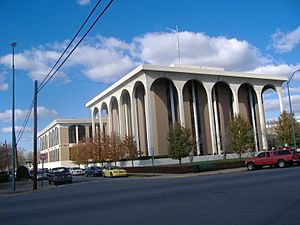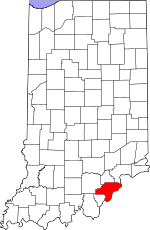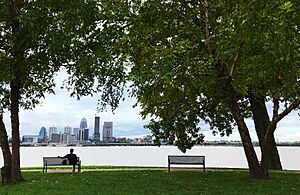Clark County, Indiana facts for kids
Quick facts for kids
Clark County
|
||
|---|---|---|

Clark County Courthouse in Jeffersonville, Indiana
|
||
|
||

Location within the U.S. state of Indiana
|
||
 Indiana's location within the U.S. |
||
| Country | ||
| State | ||
| Founded | February 3, 1801 | |
| Named for | General George Rogers Clark | |
| Seat | Jeffersonville | |
| Largest city | Jeffersonville | |
| Area | ||
| • Total | 376.45 sq mi (975.0 km2) | |
| • Land | 372.86 sq mi (965.7 km2) | |
| • Water | 3.60 sq mi (9.3 km2) 0.96%% | |
| Population
(2020)
|
||
| • Total | 121,093 |
|
| • Density | 320/sq mi (120/km2) | |
| Time zone | UTC−5 (Eastern) | |
| • Summer (DST) | UTC−4 (EDT) | |
| Congressional district | 9th | |
|
||
Clark County is a county in the U.S. state of Indiana, located directly across the Ohio River from Louisville, Kentucky. At the 2020 census, the population was 121,093. The county seat is Jeffersonville. Clark County is part of the Louisville/Jefferson County, KY–IN Metropolitan Statistical Area.
Contents
History
Clark County lies on the north bank of the Ohio River. A significant gateway to the state of Indiana, Clark County's settlement began in 1783. The state of Virginia rewarded General George Rogers Clark and his regiment for their victorious capture of Forts Kaskaskia, Cahokia, and Vincennes from the British, by granting them 150,000 acres (610 km2) of land. A small portion of this land, 1,000 acres (4.0 km2), became known as Clarksville, the first authorized American settlement in the Northwest Territory, founded the next year in 1784.
Clark County was formed on February 3, 1801, with territory annexed from Knox, the first county formed in the Territory in 1790. This original area in Clark County was subsequently altered and reduced with the formation of other counties: Harrison (1808), Franklin, Jefferson, and Wayne (1811), Switzerland and Washington (1814), Jackson and Ripley (1816), Jennings (1817), Crawford and Randolph (1818), Fayette and Floyd (1819), Scott (1820), Union (1821), Decatur and Rush (1822).
The first county seat was established in Springville, on April 7, 1801. Jeffersonville was platted in 1802, and on June 9 the Territorial Governor (William Henry Harrison) ordered that it be regarded as the county seat. However, on December 14, 1810, the seat designation was given to Charlestown, which retained the designation until 1873, when on September 23 the Jefforsonville mayor (Luther Warder) successfully campaigned for the county seat's return.
Clark County was a hotbed for antislavery sentiment during the territorial period. In 1807, citizens petitioned Congress to uphold the legal prohibition of slavery established in the Northwest Ordinance in response to efforts by Harrison and his supporters to have the prohibition repealed. Many settlers were Quakers who had migrated from North Carolina to escape the oppressive conditions of the slave states and did not want to see slavery be established in Indiana.
From its beginning Clark County's history, culture and growth have been linked to the development of the river. Early nineteenth-century steamboats transported goods to the upper Ohio, providing opportunities for commercial and industrial growth in the county. In 1832, James Howard founded the Howard shipyards making Clark County a leader in shipbuilding.
The railroad brought further economic growth. The Monon line spanned from New Albany to Chicago, and the Jeffersonville, Madison, and Indianapolis Railroad provided Clark County and southern Indiana with access to the northern trading centers of Indianapolis and Chicago.
Industries locating to Clark County during the nineteenth century included the Louisville Cement Company in Speed, Indiana and the Ford Plate Glass Company established in Jeffersonville in 1876.
During the 1920s, Clark County attracted the Colgate-Palmolive Company to the Clarksville Riverfront. Colgate purchased the former Indiana Reformatory building in 1923. The company rehabilitated and adapted the building for its dedication in 1924. It stayed in business until early 2008.
During World War II the county prospered. The federal government began the Indiana Arsenal near Charlestown in 1940. Producing smokeless powder for the war effort, the arsenal employed up to 20,000. Howard shipyards was commissioned by the Navy to produce landing craft. Later Howard shipyards reorganized as Jeffersonville Boat and Machine Company (Jeffboat) — a current major employer (1991).
When the war ended, the county experienced significant residential and commercial growth, aided by the 1956 Interstate Act. The improved access provided by Interstate 65 encouraged additional subdivisions and shopping centers.
Clark County history has been closely associated with the development of the Ohio River. From its beginnings, Clark County relied on the river for economic opportunities. Clark County has diversified its economic base, lessened its dependency on the river, and continues to develop in new directions. However, the county still looks to the river as one link to its significant pioneer heritage.
Geography
Clark County lies on the east edge of Indiana; its eastern border abuts the northern border of the state of Kentucky (across the Ohio River). The terrain is low rolling hills, with the area either devoted to agriculture or urban development. The west part of the county is carved with drainages. The highest point on the terrain is a ridge WNW of Henryville near the border with Scott County, at 1,030 ft (310 m) ASL.
According to the 2010 census, the county has a total area of 376.45 square miles (975.0 km2), of which 372.86 square miles (965.7 km2) (or 99.05%) is land and 3.60 square miles (9.3 km2) (or 0.96%) is water.
Adjacent counties
- Scott County - north
- Jefferson County – northeast
- Trimble County, Kentucky – northeast
- Oldham County, Kentucky – east
- Jefferson County, Kentucky – south
- Floyd County – southwest
- Washington County – west
Clark County is one of the few counties in the US to border two counties of the same name in different states (Jefferson County Indiana and Kentucky)-
Cities
Towns
- Borden
- Clarksville
- Sellersburg
- Utica
Census-designated places
- Henryville
- Memphis
- New Washington
Unincorporated places
Source:
- Arctic Springs
- Belknap
- Bennettsville
- Bethlehem
- Black Diamond
- Blue Lick
- Broom Hill
- Carwood
- Cementville
- Clarke
- Dallas
- Dyeton
- Floyd
- Hamburg
- Haussdale
- Henze
- Hibernia
- Hughes
- Longview Beach
- Marysville
- Nabb
- New Market
- Oak Park
- Otisco
- Otto
- Prairie Crossing
- Prather
- Pulltight
- River Ridge
- Rockford
- Solon
- Speed
- St Joseph
- Starlight
- Sunset Village
- Underwood
- Watson
- Wilson
Extinct towns
- Andalusia
- Claysburg
- Oregon
- Port Fulton
- Springville
Townships
- Bethlehem
- Carr
- Charlestown
- Jeffersonville
- Monroe
- Oregon
- Owen
- Silver Creek
- Union
- Utica
- Washington
- Wood
Transit
- Transit Authority of River City
Major highways
Airport
- KJVY – Clark Regional Airport
Climate and weather
| Weather chart for Jeffersonville, Indiana | |||||||||||||||||||||||||||||||||||||||||||||||
|---|---|---|---|---|---|---|---|---|---|---|---|---|---|---|---|---|---|---|---|---|---|---|---|---|---|---|---|---|---|---|---|---|---|---|---|---|---|---|---|---|---|---|---|---|---|---|---|
| J | F | M | A | M | J | J | A | S | O | N | D | ||||||||||||||||||||||||||||||||||||
|
3.3
41
25
|
3.3
47
29
|
4.4
57
37
|
3.9
67
46
|
4.9
75
56
|
3.8
83
65
|
4.3
87
70
|
3.4
86
68
|
3.1
79
61
|
2.8
68
49
|
3.8
56
39
|
3.7
45
30
|
||||||||||||||||||||||||||||||||||||
| temperatures in °F precipitation totals in inches source: The Weather Channel |
|||||||||||||||||||||||||||||||||||||||||||||||
|
Metric conversion
|
|||||||||||||||||||||||||||||||||||||||||||||||
In recent years, average temperatures in Jeffersonville have ranged from a low of 25 °F (−4 °C) in January to a high of 87 °F (31 °C) in July, although a record low of −22 °F (−30 °C) was recorded in January 1994 and a record high of 107 °F (42 °C) was recorded in July 1936. Average monthly precipitation ranged from 2.79 inches (71 mm) in October to 4.88 inches (124 mm) in May.
Two towns in Clark County, Marysville and Henryville suffered major damage during the tornado outbreak of March 2–3, 2012.
Demographics
| Historical population | |||
|---|---|---|---|
| Census | Pop. | %± | |
| 1810 | 5,670 | — | |
| 1820 | 8,709 | 53.6% | |
| 1830 | 10,686 | 22.7% | |
| 1840 | 14,595 | 36.6% | |
| 1850 | 15,828 | 8.4% | |
| 1860 | 20,502 | 29.5% | |
| 1870 | 24,770 | 20.8% | |
| 1880 | 28,610 | 15.5% | |
| 1890 | 30,259 | 5.8% | |
| 1900 | 31,835 | 5.2% | |
| 1910 | 30,260 | −4.9% | |
| 1920 | 29,381 | −2.9% | |
| 1930 | 30,764 | 4.7% | |
| 1940 | 31,020 | 0.8% | |
| 1950 | 48,330 | 55.8% | |
| 1960 | 62,795 | 29.9% | |
| 1970 | 75,876 | 20.8% | |
| 1980 | 88,838 | 17.1% | |
| 1990 | 87,774 | −1.2% | |
| 2000 | 96,472 | 9.9% | |
| 2010 | 110,232 | 14.3% | |
| 2020 | 121,093 | 9.9% | |
| 2023 (est.) | 125,467 | 13.8% | |
| US Decennial Census 1790–1960 1900–1990 1990–2000 2010–2019 |
|||
As of the 2010 United States Census, there were 110,232 people, 44,248 households, and 29,474 families in the county. The population density was 295.6 inhabitants per square mile (114.1 inhabitants/km2). There were 47,776 housing units at an average density of 128.1 units per square mile (49.5 units/km2). The racial makeup of the county was 87.1% white, 6.9% black or African American, 0.8% Asian, 0.3% American Indian, 2.6% from other races, and 2.2% from two or more races. Those of Hispanic or Latino origin made up 4.9% of the population. In terms of ancestry, 24.3% were German, 15.0% were Irish, 13.0% were American, and 9.8% were English.
Of the 44,248 households, 32.6% had children under the age of 18 living with them, 48.4% were married couples living together, 12.9% had a female householder with no husband present, 33.4% were non-families, and 27.6% of all households were made up of individuals. The average household size was 2.46 and the average family size was 2.98. The median age was 37.9 years.
The median income for a household in the county was $47,697 and the median income for a family was $58,090. Males had a median income of $43,053 versus $32,361 for females. The per capita income for the county was $23,592. About 9.0% of families and 11.8% of the population were below the poverty line, including 17.9% of those under age 18 and 7.5% of those age 65 or over.
2020 census
| Race | Num. | Perc. |
|---|---|---|
| White (NH) | 95,403 | 78.8% |
| Black or African American (NH) | 9,265 | 7.65% |
| Native American (NH) | 249 | 0.2% |
| Asian (NH) | 1,305 | 1.1% |
| Pacific Islander (NH) | 127 | 0.1% |
| Other/Mixed (NH) | 6,853 | 5.7% |
| Hispanic or Latino | 7,891 | 6.5% |
Education
There are three public school districts and the Archdiocese of Indianapolis that serve Clark County. The county is also served by two colleges that offer associate and bachelor's degrees.
Public school districts
Clarksville Community School Corp.
- Clarksville Senior High School
- Clarksville Middle School
- Greenacres Elementary School
- George Rogers Clark Elementary School (Closed 05/2010)
West Clark Community School Corp.
- Silver Creek High School
- Borden Jr/Sr High School
- Henryville Jr/Sr High School
- Silver Creek Middle School
- Borden Elementary School
- Henryville Elementary School
- Silver Creek Elementary School
Greater Clark County Schools
- Charlestown Senior High School
- Jeffersonville High School
- New Washington High School
- Charlestown Middle School
- New Washington Middle School
- Parkview Middle School
- River Valley Middle School
- Bridgepoint Elementary School
- Maple Elementary School
- New Washington Elementary School
- Northaven Elementary School
- Parkwood Elementary School
- Pleasant Ridge Elementary School
- Jonathan Jennings Elementary School
- Riverside Elementary School
- Spring Hill Elementary School
- Thomas Jefferson Elementary School
- Utica Elementary School
- Wilson Elementary School
- Options Alternative School
- Corden Porter School
Private schools
- Archdiocese of Indianapolis
- Our Lady of Providence Junior-Senior High School
- St. Anthony of Padua Elementary School(K–7)
- Sacred Heart of Jesus (PK–8)
- St. John Paul II School(K–8)
Colleges and universities
- Ivy Tech State College (Non-profit)
- Mid-America College of Funeral Services (Non-profit)
- Ottawa University – Jeffersonville (Non-Profit)
See also
 In Spanish: Condado de Clark (Indiana) para niños
In Spanish: Condado de Clark (Indiana) para niños



